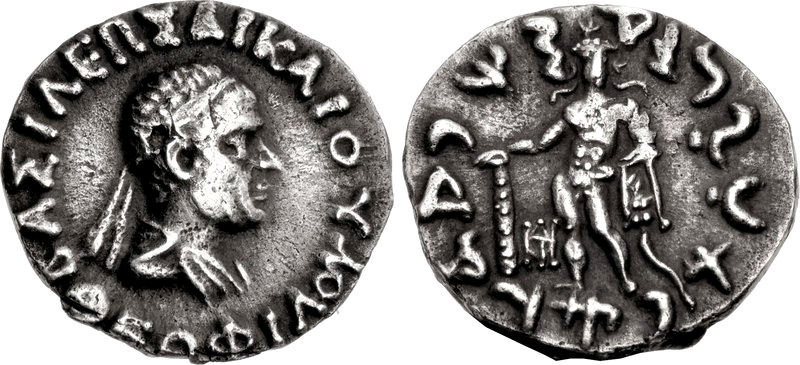Theophilus (Indo-Greek) on:
[Wikipedia]
[Google]
[Amazon]
 Theophilus Dicaeus () was a minor
Theophilus Dicaeus () was a minor
Image:Theophilos-634.jpg,
 Theophilus Dicaeus () was a minor
Theophilus Dicaeus () was a minor Indo-Greek
The Indo-Greek Kingdom, also known as the Yavana Kingdom, was a Hellenistic period, Hellenistic-era Ancient Greece, Greek kingdom covering various parts of modern-day Afghanistan, Pakistan and northwestern India.
The term "Indo-Greek Kingdom" ...
king who ruled for a short time in the Paropamisadae
Paropamisadae or Parapamisadae () was a satrapy of the Alexandrian Empire in modern Afghanistan and Pakistan, which largely coincided with the Achaemenid province of Parupraesanna. It consisted of the districts of Sattagydia (Bannu basin), Ga ...
. He was possibly a relative of Zoilus I
Zoilus I Dicaeus (; epithet means "the Just") was an Indo-Greek king who ruled in Afghanistan and Pakistan, and occupied the areas of the Paropamisade and Arachosia previously held by Menander I. He may have belonged to the dynasty of Euthydemu ...
and is only known from coins. It is possible that some of Theophilus' coins in fact belong to another ruler, in Greek Bactria, during approximately the same period.
Time of reign
While Bopearachchi suggests c. 90 BCE, R. C. Senior believes that Theophilus ruled in the 130s BCE. Both numismatics do however suggest that the reigns of Theophilus andNicias
Nicias (; ; 470–413 BC) was an Athenian politician and general, who was prominent during the Peloponnesian War. A slaveowning member of the Athenian aristocracy, he inherited a large fortune from his father, and had investments in the silv ...
were adjacent.
Coins of Theophilos
Just like Zoilus I, Theophilus struck Indian silver coins with Heracles, a common symbol of the house ofEuthydemus I
Euthydemus I (Greek: , ''Euthýdēmos'', – 200/195 BC) was a Greco-Bactrian king and founder of the Euthydemid dynasty. He is thought to have originally been a satrap of Sogdia, who usurped power from Diodotus II in 224 BC. Literary sources ...
, and the epithet Dikaios/Dhramikasa ''"The Just/Follower of the Dharma".'' The monograms are mostly the same as those of Nicias
Nicias (; ; 470–413 BC) was an Athenian politician and general, who was prominent during the Peloponnesian War. A slaveowning member of the Athenian aristocracy, he inherited a large fortune from his father, and had investments in the silv ...
. The bronzes have similar inscriptions.
Bronzes of Theophilos:
Heracles
Heracles ( ; ), born Alcaeus (, ''Alkaios'') or Alcides (, ''Alkeidēs''), was a Divinity, divine hero in Greek mythology, the son of ZeusApollodorus1.9.16/ref> and Alcmene, and the foster son of Amphitryon.By his adoptive descent through ...
with lion skin, and his club on the reverse.
A Bactrian king Theophilus?
There is a wholly different, and very rare, Attic-weight coinage of a king Theophilus. Found in Bactria, these coins feature a reverse with a seated Athena with Nike, a different title Autokrator "Autocrat King" (), and also a separate monogram. Although this is not a very common occurrence on Indo-Greek coins, the coins of Theophilus have generally been accepted as belonging to one unique king. Bopearachchi has supported this proposition by pointing at the similarity between the portraits and the identical treatment of the diadem (one end straight, one end crooked). Against this, JakobssonJakobsson, J: ''Theophilos Autokrator, a last Bactrian king?'' ONS Journal 202 (2010). argues that the coins issued by the later Indo-Greek kings for export into Bactria were consistently similar to these kings' regular Indian coinage. Consequently, the coins of Theophilos Autokrator were not such export issues, but should belong to a Bactrian ruler. Jakobsson suggests that Theophilus Autocrator was a Bactrian princelet who briefly maintained himself in some part of Bactria, after the Hellenistic kingdom there had been vanquished by nomads, presumably in the 120s BCE.See also
*Greco-Bactrian Kingdom
The Greco-Bactrian Kingdom () was a Ancient Greece, Greek state of the Hellenistic period located in Central Asia, Central-South Asia. The kingdom was founded by the Seleucid Empire, Seleucid satrap Diodotus I, Diodotus I Soter in about 256 BC, ...
* Greco-Buddhism
Greco-Buddhism or Graeco-Buddhism was a cultural syncretism between Hellenistic culture and Buddhism developed between the 4th century BC and the 5th century AD in Gandhara, which was in present-day Pakistan and parts of north-east Afghanis ...
* Indo-Scythians
The Indo-Scythians, also known as Indo-Sakas, were a group of nomadic people of Iranic Scythian origin who migrated from Central Asia southward into the present-day regions of Afghanistan, Eastern Iran and the northwestern Indian subcontinent: p ...
* Indo-Parthian Kingdom
The Indo-Parthian kingdom was a Parthian kingdom founded by Gondophares, and active from 19 CE to c. 226 CE. At their zenith, they ruled an area covering parts of eastern Iran, various parts of Afghanistan and the northwest regions of the Indian ...
* Kushan Empire
The Kushan Empire (– CE) was a Syncretism, syncretic empire formed by the Yuezhi in the Bactrian territories in the early 1st century. It spread to encompass much of what is now Afghanistan, Eastern Iran, India, Pakistan, Tajikistan and Uzbe ...
Notes
References
* ''The Greeks in Bactria and India'', W.W. Tarn, Cambridge University Press. {{Hellenistic rulers Indo-Greek kings 1st-century monarchs in Asia